
By Steve Benner for CoinWeek …..
The god Achelous was associated with the Achelous River, the largest river in Greece. This river still flows from the Pindar Mountains through western Greece and down into the Ionian Sea. It formed the border between Akarnania and Aetolia for part of its length.
Like other river gods, Achelous was the son of the Titans Oceanus and Tethys, though some say his mother was Gaia (Earth). He was considered the oldest and most honored of the river gods, and his cult spread throughout ancient Greece – including Magna Graecia in Italy. Achelous is said to be the father of the Sirens of Odyssey fame, and of many nymphs of springs, such as Corinthian Pirene, Delphian Castalia, and Theban Dirce, to name just a few. One of his daughters, Kallirrhoe, married the Argive hero Alkmaion after he had been purified by her father.
Famously, Achelous could change his shape into a bull, snake, or half-man/half-bull; this latter being the shape with which he is most associated. In the shape of a bull, he fought Herakles for the hand of Deianeira in marriage. Herakles beat him, tearing off one of his horns in the struggle. These stories of Achelous go back to at least the time of Homer, though the origin of his name may be Semitic, relating back to the Middle East and the Bronze Age.
Achelous in Akarnania
The area of ancient Greece most closely associated with Achelous was Akarnania.
Akarnania was the area west of the Pindar Mountains and Aetolia to the Ionian Sea, north of the Gulf of Corinth, and south of the Ambracian Gulf, which separated Epiros from Akarnania. In myth, Akarnania was said to have been founded by Akarnan, the son of Kallirrhoe and Alkmaion.
Little is known of the area before Corinth began to establish colonies there in the seventh century BCE. But by the end of the fifth century, Akarnanian cities had formed a culturally and ethnically unified confederation with their capital at Stratos (see Figure 1). Stratos was located on the Achelous River in the interior and used the head of Achelous on its coins (see Figure 2). This early coin shows Achelous’ head with his horns and a pointed beard. The retrograde “F” in the reverse is probably the denomination (“T” for a trihemiobol).

Because its neighbors and the great powers of ancient Greece were constantly attacking Akarnania, the coin weight standard used by Akarnania was always in flux.
The Corinthian standard was used up until Corinth was driven out of the area by Athens in 424, when the Attic standard began being used. After Macedonia’s Philip II defeated the Greek forces at Chaeronea in 338, the area fell under Macedonian control. In 255, Aetolia and Epiros conquered Akarnania, and the Aetolian standard was used for a while.
The Confederation was reconstituted in 230 with Leukas as its capital after Aetolia kept the city of Stratos, then later Thyrrheion became the capital. The Confederacy ended in 167 when Rome took over the province.
Achelous was used on the coinage throughout the life of the Confederacy. Figure 3 shows a quarter gold stater with Achelous clean-shaven on the obverse. The same image of Achelous and Apollo reverse appeared on the Confederation’s silver drachms and staters. Figure 4 shows a federal coin in the style of the Corinthian pegasus.
Because Akarnanian cities continued to deal with Corinthian colonies in Magana Graecia, they continued to mint these Corinthian type coins even after Corinth had be driven out of the area. Figure 5 shows one of these coins from Thyrrheion with pegasus obverse and Athena reverse. A small head of Achelous is on the reverse just to the right of Athena’s head. Other Akarnanian cities, such as Anaktorion, Leukas, and Argos Amphilochikon, also minted this type of coin.
The fourth Akarnanian coin is a local bronze issue from the city of Oinaidai, located near the southern end of Akarnania. It has Zeus on the obverse and Achelous on the reverse. This coin shows Achelous more in the guise of a Zeus with a full beard. This issue is relatively common and inexpensive.
Achelous in Magna Graecia

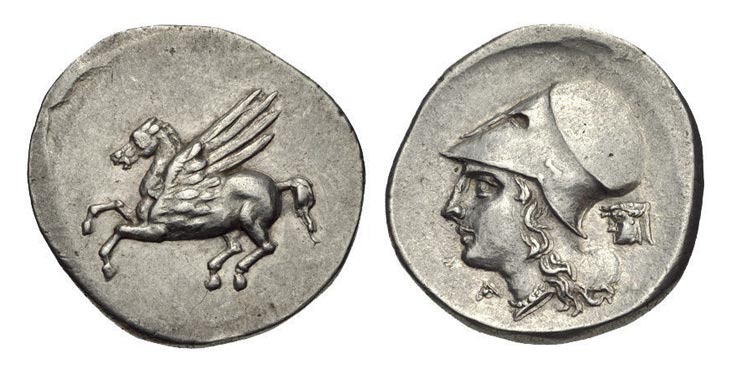
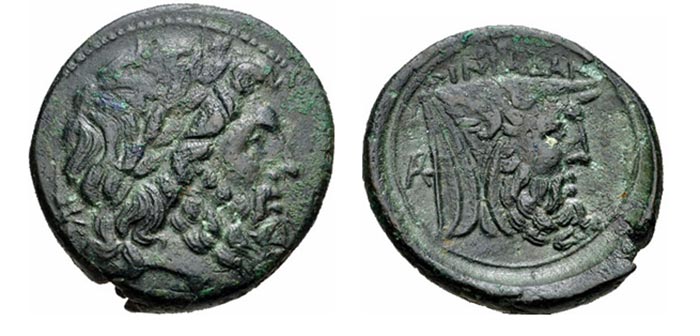
As mentioned, the cult of Achelous spread throughout the Greek world, and several cities in Magna Graecia also used his image on their coins.
One of the most well-known cities using this god was Gela in southern Sicily (see Figure 1). Gela was settled by colonists from Rhodes and Crete around 688 BCE by the river Gela. It became a powerful city, and for a time rivaled Syracuse for control of eastern Sicily, but the Carthaginians sacked the city in 405 and again in 311. The Mamertini destroyed the city in either 287 or 281 BCE, but Gela has survived and is still a major city in Sicily today. Figure 6 shows an obverse of a quadriga, or four-horse chariot, with Victory overhead – a reference to Gelon’s Olympic win in 488. This obverse was also used frequently on Syracusian coins. The reverse is a very nice depiction of Achelous, relating to the river Gela in this case. Figure 7 shows a similar Gela coin with a horseman on the obverse. The Achelous on the reverse does not have the mustache and is smiling slightly.


Another city that frequently used Achelous on its coins was Neapolis (modern Naples). It is located about two-thirds of the way down the western coast of Italy on the Bay of Naples. Neapolis was founded by Cumaean colonists in 650 BCE and grew to become a powerful city in the Campania region. It sided with the Roman Republic during the Second Punic War (218-201) and during the Samnite Wars in the third and fourth centuries.
Neapolis’ name was changed to Naples during the Middle Ages.
Figure 8 shows a nomos from Neapolis with Achelous (Achelous Sebethos) as a bull with a human head being crowned by Victory. This is a clear indication that communities took great pride in their sources of water. This reverse was the predominant type for Neapolitan coins. Figure 9 shows a Neapolitan bronze coin with the forepart of Achelous as a man-headed bull facing right.
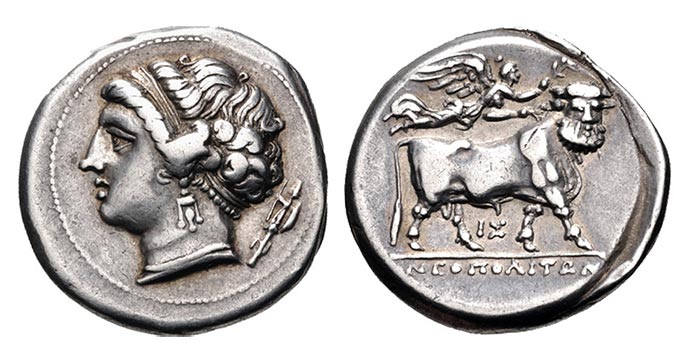

Another city in Sicily also put Achelous on its coins, Agyrion. Agyrion was an ancient Sikel (native Sicilians) city that was ruled by the powerful tyrant Agyris. He fought successfully against the Carthaginians in 392 BCE. In 339, Timoleon of Syracuse moved 10,000 Greeks into the city, converting it from a native to a Greek city. Agyrion still exists today and is called Agira. Figure 10 shows a young male’s head, which may be the river god Chrysas, facing right. On the reverse is Achelous (Achelous Palagkaios) facing right. “Palagkaios” was probably the Sikel name for today’s Salso River.
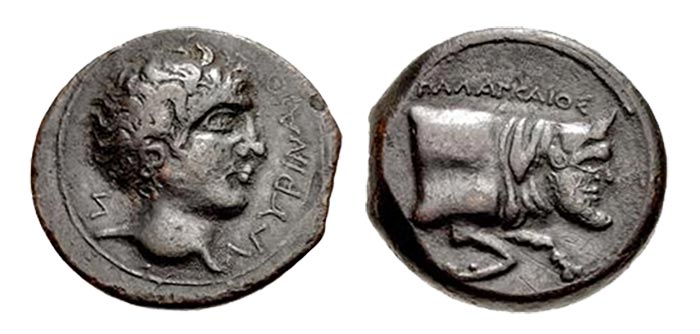
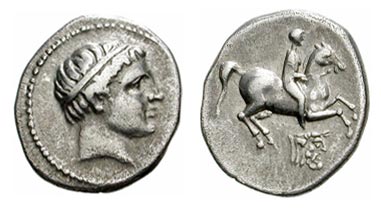
In Figure 11 shows a 1/5 tetradrachm minted probably at Amphipolis by Kassander, Philip IV, or Alexander (son of Kassander). It is included to show the widespread popularity of Achelous. The reverse has a boy riding a horse to the right, and below the horse is the head of Achelous facing right.
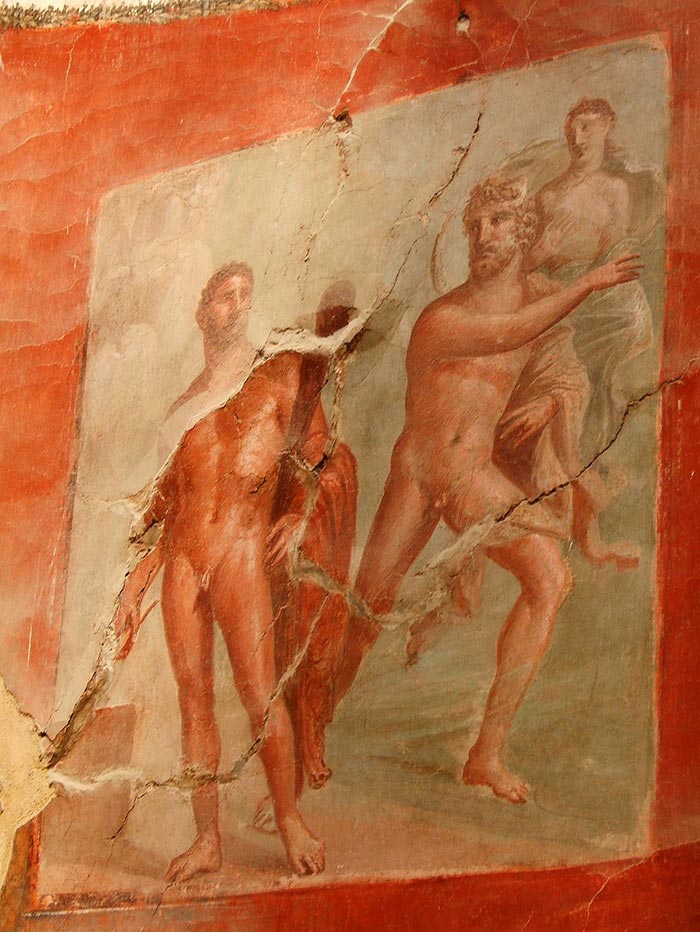
The Romans also appreciated Achelous though apparently not enough to put his image on their coins. Figure 12 is a wall painting from a villa buried by Mt. Vesuvius in the town of Herculaneum. It shows Achelous as a man with bull’s horns.
* * *
References
Benner, Steve. “History and Coinage of the Ancient Greek Leagues: Fifth through First Centuries B.C.”, Classical Numismatic Studies 11 (2018).
Bullfinch, Thomas. Bulfinch’s Mythology, Lea Edition. Canterbury Classics (2014).
Classical Numismatic Group (CNG)
Grant, Michael. A Guide to the Ancient World: A Dictionary of Classical Place Names. Barnes and Noble (1986).
Head, Barclay V. Historia Numorum: A Manual of Greek Numismatics. Oxford (1887).
Hoover, Oliver D. Handbook of Coins of Italy and Magna Graecia, Sixth to First Centuries BC [The Handbook of Greek Coinage Series, Volume 1]. Classical Numismatic Group, LLC (2018).
–. Handbook of Coins of Sicily (including Lipara), Civic, Royal, Siculo-Punic, and Romano-Sicilian Issues, Sixth to First Centuries BC [The Handbook of Greek Coinage Series, Volume 2]. Classical Numismatic Group, LLC (2012).
–. Handbook of Coins of Macedon and Its Neighbors. Part I: Macedon, Illyria, and Epeiros, Sixth to First Centuries BC [The Handbook of Greek Coinage Series, Volume 3]. Classical Numismatic Group, LLC (2016).




